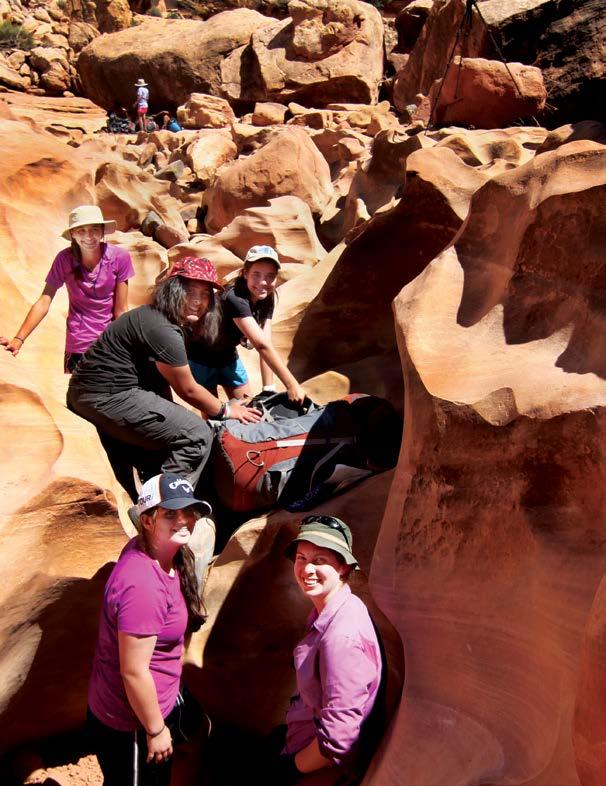

Leader
Failure it ’ s something we strive to avoid at all costs the terriF ying thing is—we are raising a generation afraid of failing. This theme is interwoven in several articles in this issue.
At NOLS, one of our primary teaching methods is letting students learn from their mistakes. We allow students to develop grit through failure. Whether that means hiking in the wrong direction, missing steps of their patient assessment in a scenario, or arguing with co-workers during a leadership training, we value teaching our students leadership in uncertainty.
Why? Failure creates more competent leaders. It takes great self-awareness to admit you were wrong, and to re-examine your actions. Students leave NOLS knowing how to debrief and make fewer mistakes in the future.
This issue’s cover feature is on the Archer School for Girls, a school whose core competencies include “The Character and Drive to Lead.” In 7th, 9th and 11th grades, Archer students come to NOLS for one-week backpacking courses called “Arrow Week”—a stark contrast from life in urban Los Angeles. Talk about a venue for developing grit.
One student reflected:
“I came into Arrow Week full of anxiety, tired, and hoping that the week would go by as quickly as possible … I’ve grown as a person since then and I've realized that Arrow Week is the best. I’ve learned how to cope with difficult situations, how to stay positive, how to be gritty, how to learn to love something, and how to stay in the present. I’ve changed a lot because of Arrow Week and I am so grateful that I have. I believe in the NOLS mission. I believe that I have become a better person because of NOLS.”
Moving into our 51st year, we aim to engage, educate, and expose even more students to the NOLS experience.
At NOLS, we have revamped our brand structure to communicate about our school. In this issue, you will notice that we have changed our brand architecture and naming conventions.
We feel NOLS has heart, and that the wilderness lies in wait for everyone.
John Gans, NOLS Executive Director

Editor
Kim Freitas
Designers
Kristen Lovelace
Liz Schultz
Anna Boyle
Nikole Wohlmacher
Alumni Relations Director
Rich Brame
NOLS Executive Director
John Gans
Creative Director
Brad Christensen
Art Director
Eryn Pierce
Editorial Board
Bruce Palmer
Anne McGowan
Pip Coe
Melissa Hemken
Molly Herber
August 2016 • Volume 31 • No.3
Published three times a year in April, August, and November.
Postmaster: Send address changes to NOLS
284 Lincoln St. Lander, WY 82520
The Leader is a magazine for NOLS alumni which is a nonprofit school focusing on wilderness skills, leadership, and environmental ethics. It is mailed to approximately 71,000 NOLS alumni. NOLS graduates living in the U.S. receive a free subscription to The Leader for life.
The Leader accepts paid advertising and welcomes article submissions and comments. Please address all correspondence to leader@nols.edu or call (307) 332-8800. Alumni can direct address changes to alumni@nols.edu or (800) 332-4280. For the most up-to-date information on NOLS, visit www.nols.edu or email admissions@nols.edu.
The Leader is printed with soy-based inks in Portland, Ore., on paper using 10 percent post-consumer-recycled content. The Leader is available online at www.nols. edu/alumni/leader.
Cover photo credit Brian Hensien

WHO IS THIS?
Recognize this person? The first 10 people to contact us with the correct answer will receive a free NOLS t-shirt. Call NOLS Alumni at (800) 332-4280 or email alumni@nols.edu.

ANSWER TO LAST ISSUE
The answer to last issue’s “Who Is This?” is Molly Doran. She spent years instructing NOLS courses in North America, South America, and Africa.
Departments
5 FIELD NOTES: Let the Mountains Teach Us—To Fail
6 ISSUE ROOM: Chugach National Forest Plan
7 WILD SIDE OF MEDICINE: First Responder for Your Own Head Injury
8 ALUMNI PROFILE: Learning to Go Off Trail in the Wind River Range
9 ALUMNI PROFILE: The Adventure Rolls On
20 ALUMNI TRIPS: Return to the Backcountry with Friends
21 REVIEWS: Way of Wanderlust and Mother Nature’s Child
22 GEAR ROOM: Lamina Z Sleeping Bag Review
24 RECIPE BOX: Backcountry Cheesecake
25 JABBERWOCKY: Read up on your coursemates’ lives
26 SCHOOL NOTES: Updates from various locations
27 SUSTAINABILITY: Planting Memories
28 BELAY OFF: Blizzards, Newswires, and Teton Climbs
30 INSTRUCTOR PROFILE: Q&A with Katie Baum Mettenbrink
31 TRAVERSES: Desolation Canyon in July Features
10 WHICH NOLS WILDERNESS MEDICINE COURSE IS RIGHT FOR YOU?
We outline the various wilderness medicine course offerings.
12 THE HISTORY OF LEAVE NO TRACE NORWAY
Ervin Mejía recounts bringing these courses to his home country.
14 PEER EMPOWERMENT FOR ACADEMIC SUCCESS
Zion Garcia started a peer-to-peer tutoring program at his high school.
16 EXTRAORDINARY YOUNG WOMEN: NOLS AND THE ARCHER SCHOOL FOR GIRLS
NOLS Custom Education runs courses for high school girls from Los Angeles.
Contributors




GREG VEREGIN Wild Side of Medicine, pg 7
Veregin has followed the road less traveled to adventures across multiple states and provinces, baking sourdough biscuits and trail running as he goes. A Wilderness First Responder and certified BodyTalk™ practitioner, he is usually found with dirt underfoot somewhere off the beaten path.
Buer is a Wyoming native and NOLS Wilderness Medicine’s Marketing Coordinator. She loves music and design, and outside the office enjoys performing with her guitar, chasing powder on her snowboard, and spending time with her family and other half.
ASHLEY DRAKE Feature, pg 16
Drake is an Operations Coordinator for NOLS Custom Education. She has visited over 24 countries and when at home she can be found skiing, hiking, or beating her husband at strategic board games.
Claytor hails from Virginia, and is a NOLS Semester in Tanzania ‘14 graduate. When not working in the NOLS Admission office, you can find him around Lander enjoying playing with his dog, Pasta.
SARAH BUER Alumni Profile, pg 9
LOGAN CLAYTOR Recipe Box, pg 24



NOLS Instagram
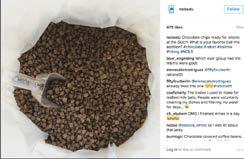
We asked: Chocolate chips are ready for rations at the Gulch! What is your favorite trail mix addition?
You said:
• csoflaherty : The trades I used to make for malted milk balls. People were voluntarily cleaning my dishes and filtering my water for days...
• bumlogic: Chocolate covered coffee beans, honey roasted peanuts, Swedish Fish, marshmallows.
• mia.papa: Pretzels with peanut butter in them!
• wiehestudios: Fond memories of the Gulch. Thanks for sharing pic.
• ty_rex317: My first reaction upon seeing this was that I got mad that we didn’t get these in our rations for my courses in Australia. Then I remembered my courses were in Australia.
What do you think? Join the conversation.
Send your feedback to leader@nols.edu, post on Facebook, tweet it, share on Instagram (@NOLSedu), or give us at call at (800) 710-6657 ext. 2254. Find past issues online at www.nols.edu/leader.
What’s Your Summit?
Buy a NOLS flag at our online store and use it to take pictures that highlight your own peak experiences. Use the hashtag #whatsyoursummit to see what fellow NOLSies are up to. See page 23 for a discount!
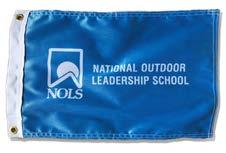


LET THE MOUNTAINS TEACH US—TO FAIL
BY COLLEEN WEARN, INSTRUCTOR
m idway through leading a backpacking expedition composed of 15 college freshmen, I asked Claire the nervous student designated to lead the day’s hike if she had ever failed. At anything, ever. She furrowed her brow and then shook her head. She could not think of a single time. Claire made the varsity volleyball team as a freshman, got straight As and earned a full ride to the University of North Carolina. She was successful by all traditional metrics, but still unsteady, unconfident.
I see students like this on every NOLS course I teach, and I worry that we are raising a generation of Claires: students who are wonderfully accomplished and terrified to fail. When I worked in admissions at Dartmouth College, I fielded calls from parents looking for advice on where to send their child to high school. Public or private? This boarding school or that one? They wanted to know the surest way to guarantee the child would go to an Ivy League school. The question came from a good place, yet it left me deeply troubled. If we orchestrate kids’ success from day one, how will they ever see that we trust them to deal with failure and to create their own future?
Now that I live in Silicon Valley, I am surrounded by an ethos that celebrates failure. My classmates at Stanford clamor to take classes like “Lean Launchpad,” which emphasize rapid prototyping (in other words: try, fail, repeat) and idolize entrepreneurs who “fail forward.” While the mantra almost seems passé now in Silicon Valley, one important upshot of this mindset is that it asks us to disentangle our self-worth from our accomplishments.
We need to model this attitude for our children, especially girls, earlier in life. We need to let go of the urge to ensure their success, and instead create more opportunities for them to take on real challenges, with real possibility of failure.
On Claire’s leader day at NOLS, for example, we hit classic “summer” weather in Norway’s mountains: sideways sleet and a full-on whiteout. I let Claire and her classmates lead and I trotted behind while they hiked for five hours in precisely the wrong direction. When we hit the Swedish border, they finally realized they had botched the navigation, big time. And then they solved their way out of the mess. They pored over maps, figured out the error, busted out emergency peanut M&Ms,
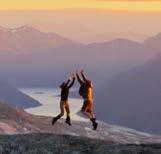
and hiked until midnight to make it to camp. When we arrived, Claire looked utterly exhausted and triumphant. In the morning she told me, “Yesterday I learned that I am capable of much more than I think I am.”
This is education at its finest. It is not a series of “right” decisions that optimize the way a student looks on a college application. It is building an environment that says: We trust you. We will be here if you really screw up. In the meantime; go make some mistakes.
Read the full story on the NOLS Blog: blog.nols.edu/2016/03/28/let-the-mountains-teach-us-to-fail/

Students work together to help each other cross a river. Roger Martin
Taking a moment to celebrate. Roger Martin
CHUGACH NATIONAL FOREST PLAN
BY EVAN REIMONDO, ENVIRONMENTAL STEWARDSHIP COORDINATOR
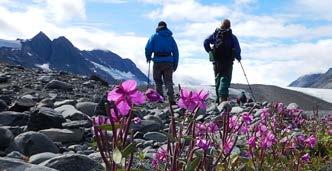
the chugach national Forest released a draft forest plan in January 2016. When finalized, this plan will guide management of the national forest for the next ten to fifteen years. NOLS developed and submitted a comment letter to the Forest Service expressing our concerns.
The primary concern for NOLS Alaska operations on the Chugach is management of the Nellie JuanCollege Fiord Wilderness Study Area (WSA), which includes a large portion of the Prince William Sound. The draft plan has several shifts in language loosening protections and allowing increases in activities like personal timber harvest, motorized uses, and construction of facilities that could degrade the wilderness characteristics of Prince William Sound.
In recent years, substantial increases in motorized vessel traffic have already impacted NOLS sea kaya-
WILDERNESS QUIZ
QUESTION
king courses in the WSA. Emphasizing the importance of pristine qualities, NOLS students routinely identify the most valuable part of their course is the remoteness and wild, natural beauty of Prince William Sound.
NOLS believes proper management of Nellie Juan-College Fiord WSA requires a strengthening of resolve, and a renewed effort of education and enforcement of the existing regulations and management direction.
The NOLS comment letter advocated for the Nellie Juan-College Fiord WSA to be again recommended for congressional wilderness designation. It is the responsibility of the Chugach National Forest to preserve the existing wilderness character of the WSA until it is either released or designated by an act of Congress.
The increased use of the WSA necessitates heightened protection, not less, in order to preserve the diversity of fish, wildlife, wilderness, scenery, solitude, and recreation opportunities of the Prince William Sound.
Which U.S. land management agency turns 100 this summer?
Answer on page 25.
Backpackers explore Prince William Sound in Alaska. Liz Schultz
CHUGACH NATIONAL FOREST
ALASKA
NOLS Alaska operates in the Chugach National Forest, located along the coast of Alaska.
FIRST RESPONDER FOR YOUR OWN HEAD INJURY
BY GREG VEREGIN, YUKON EQUIPMENT COORDINATOR ‘15
a patch oF ice , a spinning car and a rock wall left me with a concussion. The first responders were well intentioned but not well trained. Here are some things I learned.
As a patient:
Things happen fast, a clear understanding of what happened may be elusive. I remember some details but not others.
Clearly communicate what you remember. Things happened fast. I shared with first responders that I hit my head and that I did not think I was unconscious.
Get thoroughly checked by first responders. Neck, shoulder and rib pain were immediate but nausea and headaches, the early symptoms of my concussion, developed later.
Get help if you experience symptoms. I thought I was fine and self-treated with ibuprofen. Seeing a doctor would have been a reasonable precaution.
Thank your responders. There are

legitimate dangers involved in getting to the patient and getting back safely. A simple please or thank you can go a long way.
As a responder:
Do a thorough and complete patient assessment for all patients. I was A+Ox4 after the accident but the first responders on scene did not check my vital signs. It is important to have a baseline for reference in case vitals
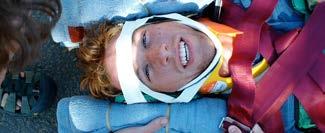
A patient at the scene of an accident. NOLS Archives
WILDERNESS MEDICINE QUIZ
TRUE OR FALSE?
It is appropriate to try to restrain a patient having a seizure. Answer on page 27.
change over time.
Empathize with the patient. I have a better understanding of why patients become irritated with the repetition of questions throughout the patient assessment.
Maintain a positive attitude towards the patient. Be kind and compassionate. Tone of voice, body language, vocabulary, and lines of questioning can influence a patient’s cooperation and willingness to be open and honest about what happened, and how they are feeling.
Engage the patient. My incident occurred while traveling solo in unfamiliar territory, and I felt overwhelmed and alone. Knowing a first responder was concerned with my well-being would have been a huge comfort.
My NOLS Wilderness Medicine training helped me to seek treatment when my symptoms of concussion persisted. I highly recommend taking a course, as you never know when your first aid skills will be called upon.
Demonstrating proper head splinting technique. Travis Welch
LEARNING TO GO OFF TRAIL IN THE WIND RIVER RANGE
BY KATHERINE BOEHRER, SOCIAL MEDIA COORDINATOR
when steve k atz saw nols’ now iconic Thirty Days To Survival on television in 1970, he knew he had to make the mountains a part of his future. That summer, he boarded a train in New York City and headed out for adventure with NOLS in Wyoming’s Wind River Range.
Struck by the landscape’s beautiful colors and the vastness of the wilderness, Katz recalls magical moments from that course, including an unforgettable night hike and gorging on berries with his coursemates during their “survival” section. Like many NOLS students before and after him, he remembers the extreme burden of their heavy packs and the taste of fresh-caught trout.
Today, Katz is the publisher of Mother Jones, a nonprofit, independent print and online journalism outlet. Katz also worked at Earthjustice, the nation’s largest nonprofit environmental law organiza-
tion and several other environmental and social justice nonprofits. He believes his career in nonprofits and the environment was certainly influenced by his NOLS experience.
“I came out of the Winds in the summer of 1970 with the confidence that I could manage whatever came my way. My career path has not been a typical one, I kind of took advantage of opportunities as they arose and always had a sense of wanting to do work that was really focused on some kind of social change, and so there’s a certain kind of risk involved in stepping outside of the expected routines and life choices. In a sense, that’s what NOLS does … It teaches you how to be ready to go off trail and make your own way.”
Katz also says that NOLS taught him several lessons that he still uses. Reflecting on his course, he remembers the value of working with a team of vir-
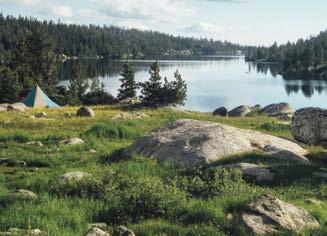

tual strangers. “We really had to learn how to work with each of the ten or so who was in the group …” Still today, he remembers the lesson of “how important it is to give the team the chance to come together and to recognize that, in their own way, everybody is a leader.”
Finally, Katz says he learned the value of living in the moment while still looking ahead and being prepared. “In those five weeks, it was like you had to be completely there, every day, to do the things that had to be done and to really enjoy the incredible, noble, powerful beauty of this place and at the same time get to the next resupply point!”
When asked what advice he would give to today’s NOLS grads who are weighing how their inputs on global, national, or local issues can make a difference, Katz, the publisher, PhD, and veteran of many uphill social causes says: “Roll up your sleeves, and get to work.”
Mother Jones, based in San Francisco and first published in hard copy in 1976, now has 10 million combined online and print readers as well as a staff of 75 journalists, technologists, and publishing professionals in New York, San Francisco, and Washington, D.C.
Each summer, students still come to NOLS to explore the Wind River Range. Courtesy of Nicholas Byrne
The Wind River Range was a memorable place for Katz. Courtesy of Nicholas Byrne
THE ADVENTURE ROLLS ON
BY SARAH BUER, WILDERNESS MEDICINE MARKETING COORDINATOR

e ric thompson is on the go, in more ways than one. He decided to earn his Wilderness EMT, which brought him to Lander, Wyoming.
“It was definitely a very high level, professional course that was not only technically accurate but also engaging in a fun way,” he said of his time here in 2008. “We got to do the full immersion, which was really advantageous. Whenever you couple that with the handson scenario training for wilderness, it definitely prepares folks much better than a lot of more traditional EMT classes.”
Thompson said his completion of the WEMT course helped with his career as a commercial raft leader, making it easier to get job interviews, move to various places, and to act as medical personnel on trips.
November 12, 2012, Thompson’s world took a turn when he was in a car accident that paralyzed him from the waist down.
“Working as a wilderness EMT ... you end up in a lot of those challenging positions where there’s never enough resources available to make it right,” he said.
“The situations can be very challenging—and very messed up—at times, but the fact of the matter is you don’t have time to be concerned about what you don’t have, it’s more about being prepared and figuring out how to make the most of a situation.”
Today, Thompson is an athletic public figure. When he’s not pushing boundaries in the outdoor industry, Thompson works as an advocate for the disabled community, promoting ADA compliance to allow disabled individuals to safely access public establishments.
“Very shortly after my accident, I realized that the region I live in West Virginia is terribly inaccessible and non-compliant with general universal accessibility, and no one was doing
anything about it” Thompson said.
He aims to change that, promoting places that are accessible and using direct advocacy to implement changes to give disabled individuals better access. Currently, he is working on building his nonprofit, WVOnTheGo, whose mission is to help local businesses better serve clientele of all abilities and grow the local sustainable economy.
Thompson’s message is one of resilience, optimism, and determination. He is an inspiration—as a WEMT graduate, an athlete, an advocate, and as an unstoppable individual. As he would put it:
“‘Handicap’ just means you work harder, not that you’re disabled. The adventure rolls on.”
Read the full story on the NOLS Blog: blog.nols.edu/2016/03/25/the-adventurerolls-on-thriving-through-adversity-witheric-thompson/
Exploring the great outdoors of Mayflower Gulch, Colorado. Courtesy of Eric Thompson
